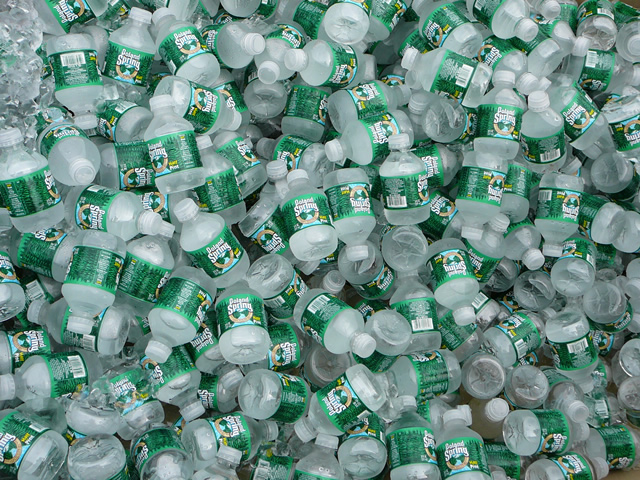In 2010 the world spent around $50 Billion on bottled water, with over a third accounted for by the United States alone. During this period the United States House of Representatives spent $860,000 on bottled water for its 435 members. This is close to $2,000 per person per year. (Figures according to Corporate Accountability International).
This is despite the fact that on average bottled water costs around 1,900 times more than it’s cheaper, less glamorous sibling — tap water. Bottled water has become a truly big business even though science shows no discernible benefit of bottled water over that from the faucet. In fact, around 40 percent of bottled water comes from municipal water supplies anyway.
In 2007 Charles Fishman wrote a ground-breaking cover story on the bottled water industry for Fast Company. We excerpt part of the article, Message in a Bottle, below.
[div class=attrib]By Charles Fishman:[end-div]
The largest bottled-water factory in North America is located on the outskirts of Hollis, Maine. In the back of the plant stretches the staging area for finished product: 24 million bottles of Poland Spring water. As far as the eye can see, there are double-stacked pallets packed with half-pint bottles, half-liters, liters, “Aquapods” for school lunches, and 2.5-gallon jugs for the refrigerator.
Really, it is a lake of Poland Spring water, conveniently celled off in plastic, extending across 6 acres, 8 feet high. A week ago, the lake was still underground; within five days, it will all be gone, to supermarkets and convenience stores across the Northeast, replaced by another lake’s worth of bottles.
Looking at the piles of water, you can have only one thought: Americans sure are thirsty.
Bottled water has become the indispensable prop in our lives and our culture. It starts the day in lunch boxes; it goes to every meeting, lecture hall, and soccer match; it’s in our cubicles at work; in the cup holder of the treadmill at the gym; and it’s rattling around half-finished on the floor of every minivan in America. Fiji Water shows up on the ABC show Brothers & Sisters; Poland Spring cameos routinely on NBC’s The Office. Every hotel room offers bottled water for sale, alongside the increasingly ignored ice bucket and drinking glasses. At Whole Foods, the upscale emporium of the organic and exotic, bottled water is the number-one item by units sold.
Thirty years ago, bottled water barely existed as a business in the United States. Last year, we spent more on Poland Spring, Fiji Water, Evian, Aquafina, and Dasani than we spent on iPods or movie tickets–$15 billion. It will be $16 billion this year.
Bottled water is the food phenomenon of our times. We–a generation raised on tap water and water fountains–drink a billion bottles of water a week, and we’re raising a generation that views tap water with disdain and water fountains with suspicion. We’ve come to pay good money–two or three or four times the cost of gasoline–for a product we have always gotten, and can still get, for free, from taps in our homes.
When we buy a bottle of water, what we’re often buying is the bottle itself, as much as the water. We’re buying the convenience–a bottle at the 7-Eleven isn’t the same product as tap water, any more than a cup of coffee at Starbucks is the same as a cup of coffee from the Krups machine on your kitchen counter. And we’re buying the artful story the water companies tell us about the water: where it comes from, how healthy it is, what it says about us. Surely among the choices we can make, bottled water isn’t just good, it’s positively virtuous.
Except for this: Bottled water is often simply an indulgence, and despite the stories we tell ourselves, it is not a benign indulgence. We’re moving 1 billion bottles of water around a week in ships, trains, and trucks in the United States alone. That’s a weekly convoy equivalent to 37,800 18-wheelers delivering water. (Water weighs 81/3 pounds a gallon. It’s so heavy you can’t fill an 18-wheeler with bottled water–you have to leave empty space.)
Meanwhile, one out of six people in the world has no dependable, safe drinking water. The global economy has contrived to deny the most fundamental element of life to 1 billion people, while delivering to us an array of water “varieties” from around the globe, not one of which we actually need. That tension is only complicated by the fact that if we suddenly decided not to purchase the lake of Poland Spring water in Hollis, Maine, none of that water would find its way to people who really are thirsty.
[div class=attrib]Please read the entire article here.[end-div]
[div class=attrib]Image courtesy of Wikipedia.[end-div]

